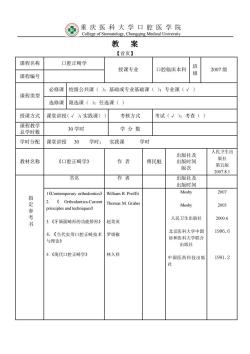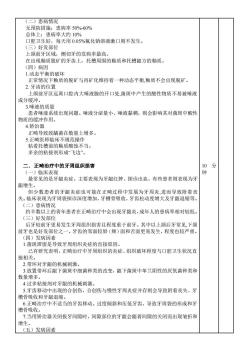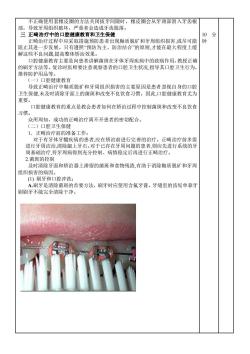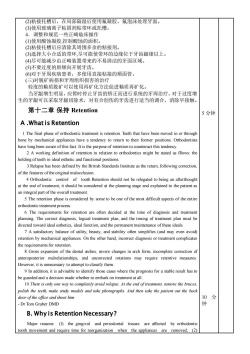重庆医科大学:《口腔正畸学》课程教学资源(授课教案)口腔健康教育、卫生保健及保持

⑥重庆压科大学口隐医学院 教案 【首页】 课程名称 口腔正畸学 授课专业 口腔临床本科 班 2007级 课程编号 必修课 校级公共课():基础或专业基础课():专业课(√) 课程类型 选修课 限选课():任选课() 授课方式 课堂讲授(√):实践课() 考核方式 考试(√):考查() 课程教学 总学时数 30学时 学分数 学时分配 课堂讲授30 学时: 实践课 学时 出版社及 人民卫生出 教材名称 《口腔正畸学》 作者 傅民魁 出版时间 版社 版次 第五版 2007.8.1 书名 作者 出版及 出版时间 1《Contemporary orthodontics》 William R.Proffit Mosby 2007 指定参考书 2.Orthodontics-Current Thomas M.Graber principles and techniques Mosby 2005 3.《牙颌面畸形的功能矫形》 赵美英 人民卫生出版社 2000.6 北京医科大学中国 4.《当代实用口腔正畸技术 罗颂椒 1996.6 协和医科大学联合 与理论》 出版社 5.《现代口腔正畸学》 林久祥 中国医药科技出版 1991.2
重 庆 医 科 大 学 口 腔 医 学 院 College of Stomatology, Chongqing Medical University 教 案 【首页】 课程名称 口腔正畸学 授课专业 口腔临床本科 班 级 2007 级 课程编号 课程类型 必修课 校级公共课( );基础或专业基础课( );专业课(√ ) 选修课 限选课( );任选课( ) 授课方式 课堂讲授(√ );实践课( ) 考核方式 考试(√ );考查( ) 课程教学 总学时数 30 学时 学 分 数 学时分配 课堂讲授 30 学时; 实践课 学时 教材名称 《口腔正畸学》 作 者 傅民魁 出版社及 出版时间 版次 人民卫生出 版社 第五版 2007.8.1 指 定 参 考 书 书名 作 者 出版社及 出版时间 1《Contemporary orthodontics》 2. 《 Orthodontics-Current principles and techniques》 3.《牙颌面畸形的功能矫形》 4.《当代实用口腔正畸技术 与理论》 5.《现代口腔正畸学》 William R. Proffit Thomas M. Graber 赵美英 罗颂椒 林久祥 Mosby Mosby 人民卫生出版社 北京医科大学中国 协和医科大学联合 出版社 中国医药科技出版 社 2007 2005 2000.6 1996.6 1991.2

邓锋 教授 戴红卫 教授 杜跃华 张翼 重庆医科大 授课教师 郑雷蕾 职称 讲师 单位 学附属口南 范小平 副教授 医院 教授 任媛妹 讲师 吴杨 讲师 授课时间 2011年2月22日一2011年6月7日 注:表中()选项请打“√” 该页由教研室统一填写
授课教师 邓锋 戴红卫 杜跃华 张肇森 宋锦璘 张翼 郑雷蕾 范小平 明志强 王豫蓉 张定铭 任嫒姝 吴杨 职 称 教授 教授 教授 教授 教授 讲师 讲师 副教授 副教授 教授 副教授 讲师 讲师 单 位 重庆医科大 学附属口腔 医院 授课时间 2011 年 2 月 22 日—2011 年 6 月 7 日 注:表中( )选项请打“√” ;该页由教研室统一填写

该页由授课教师填写,并在授课前两周交教研室主任审核。 周次 第16周,第15次课2011年6月7日授课教师 吴杨职称讲师 章节名称 正畸治疗中的口腔健康教育和卫生保健 备注 授课方式 理论课(√:实践课():实习() 教学时数2 掌握:保持的定义、保持的原因及保持时间。 熟悉:保持器应具备的条件。 教学 了解:保持的种类。常见保持器及预防复发的方法。 及要求 教学主要内容 时间 分配 正畸治疗中的釉质脱矿 钟 正骑治疗中的牙周组织损害 分 正畸治疗中的口腔健康教育和卫生保健 10钟10钟 What is Retention 5分钟 Why is Retention Necessary? Basic Theorems RETAINER 10钟5钟 分 分 Timing ofretention 分钟 3分钟 Preventionofrelapse 3分钟 Recovery after relapse 具体内容: 第十一章正畸治疗中的口腔健康教育和卫生保健 一正畸治疗中的釉质脱矿 10分 (一)临床表现 钟 牙齿的唇(颊)面上发现形态不规则的白垩色斑
该页由授课教师填写,并在授课前两周交教研室主任审核。 周次 第 16 周,第 15 次课 2011 年 6 月 7 日 授课教师 吴杨 职称 讲师 章节名 称 正畸治疗中的口腔健康教育和卫生保健 备注 授课方 式 理论课(√);实践课();实习( ) 教学时数 2 教 学 目 的 及 要 求 掌握:保持的定义、保持的原因及保持时间。 熟悉:保持器应具备的条件。 了解:保持的种类。常见保持器及预防复发的方法。 教 学 主 要 内 容 时间 分配 正畸治疗中的釉质脱矿 正畸治疗中的牙周组织损害 正畸治疗中的口腔健康教育和卫生保健 What is Retention Why is Retention Necessary ? Basic Theorems RETAINER Timing of retention Prevention of relapse Recovery after relapse 具体内容: 第十一章 正畸治疗中的口腔健康教育和卫生保健 一.正畸治疗中的釉质脱矿 (一)临床表现 牙齿的唇(颊)面上发现形态不规则的白垩色斑。 10 分 钟 10 分 钟 10 分 钟 5 分钟 10 分 钟 10 分 钟 15 分 钟 4 分钟 3 分钟 3 分钟 10 分 钟

(二)患病情况 无预防措施:患病率50%60% 总体上:患病率大约10% 口腔卫生好 雪)好发部 每天用0.05%氟化钠溶液漱口则不发生 上颌前牙区域,侧切牙的发病率最高。 在出现釉质脱矿的牙齿上,托槽周围的釉质和托槽龈方的釉质。 (四)病因 1.动态平衡的破坏 正常情况下釉质的脱矿与再矿化维持着一种动态平衡,釉质不会出现脱矿 2.牙齿的位置 上颌前牙区远离口腔内大唾液腺的开口处,菌斑中产生的酸性物质不易被唾液 成分缓冲。 3适液的质品 患者唾液系统出现问题。唾液分泌量小、唾液黏稠,则会影响其对菌斑中酸性 物质的缓冲作用。 4.矫治器 正畸导致致龋菌在数量上增多。 5.正畸医师临床不规范操作 粘着托槽 的釉质酸蚀不当。 多余的粘接剂形成“飞边”。 二.正畸治疗中的牙周组织损害 10分 (一)临床表现 最常见的是牙银炎症。主要表现为牙银红肿、探诊出血,有些患者则表现为牙 龈增 但少数患者的牙龈炎症也可能在正畸过程中发展为牙周炎,进而导致附着丧 失。临床表现为牙周袋探诊深度增加,牙槽骨吸收,牙齿松动度增大及牙银退缩等。 (一)患病情况 约半数以上的青年患者在正畸治疗中会出现牙龈炎,成年人的患病率相对较低 (三)好发部 后牙较前牙更易发生牙周组织损害且程度重于前牙。其中以上颌后牙常见,下颌 前牙也是好发部位之一。牙齿的邻面较唇(颊)面和舌面更易发生,程度也较严重。 (四)发病因素 1菌斑滞留是导致牙周组织炎症的直接原因。 已有研究表明,正畸治疗中牙周组织的炎症、组织破坏程度与口腔卫生状况直 接相关 2.带环对牙龈的机械刺激。 3.放置带环后银下菌斑中细菌种类的改变,龈下菌斑中革兰阴性的厌氧菌种类利和 数量增多。 4过多粘接剂对牙龈的机械刺激。 5牙齿移动中出现的合创伤,合创伤与慢性牙周炎症并存则会导致附者丧失、牙 槽骨吸收和牙龈退缩。 6.正畸治疗中不适当的牙齿移动。过度倾斜和压低牙齿,导致牙周袋的形成和牙 槽骨吸收。 7.当用矫治器关闭拔牙间隙时,间隙部位的牙龈会随者间隙的关闭而出现皱折和 增生 五)发病因素
(二)患病情况 无预防措施:患病率 50%-60% 总体上:患病率大约 10% 口腔卫生好,每天用 0.05%氟化钠溶液漱口则不发生。 (三)好发部位 上颌前牙区域,侧切牙的发病率最高。 在出现釉质脱矿的牙齿上,托槽周围的釉质和托槽龈方的釉质。 (四)病因 1.动态平衡的破坏 正常情况下釉质的脱矿与再矿化维持着一种动态平衡,釉质不会出现脱矿。 2. 牙齿的位置 上颌前牙区远离口腔内大唾液腺的开口处,菌斑中产生的酸性物质不易被唾液 成分缓冲。 3.唾液的质量 患者唾液系统出现问题。唾液分泌量小、唾液黏稠,则会影响其对菌斑中酸性 物质的缓冲作用。 4.矫治器 正畸导致致龋菌在数量上增多。 5.正畸医师临床不规范操作 粘着托槽前的釉质酸蚀不当。 多余的粘接剂形成“飞边”。 二.正畸治疗中的牙周组织损害 (一)临床表现 最常见的是牙龈炎症。主要表现为牙龈红肿、探诊出血,有些患者则表现为牙 龈增生。 但少数患者的牙龈炎症也可能在正畸过程中发展为牙周炎,进而导致附着丧 失。临床表现为牙周袋探诊深度增加,牙槽骨吸收,牙齿松动度增大及牙龈退缩等。 (二)患病情况 约半数以上的青年患者在正畸治疗中会出现牙龈炎,成年人的患病率相对较低。 (三)好发部位 后牙较前牙更易发生牙周组织损害且程度重于前牙。其中以上颌后牙常见,下颌 前牙也是好发部位之一。牙齿的邻面较唇(颊)面和舌面更易发生,程度也较严重。 (四)发病因素 1.菌斑滞留是导致牙周组织炎症的直接原因。 已有研究表明,正畸治疗中牙周组织的炎症、组织破坏程度与口腔卫生状况直 接相关。 2.带环对牙龈的机械刺激。 3.放置带环后龈下菌斑中细菌种类的改变,龈下菌斑中革兰阴性的厌氧菌种类和 数量增多。 4.过多粘接剂对牙龈的机械刺激。 5.牙齿移动中出现的合创伤,合创伤与慢性牙周炎症并存则会导致附着丧失、牙 槽骨吸收和牙龈退缩。 6.正畸治疗中不适当的牙齿移动。过度倾斜和压低牙齿,导致牙周袋的形成和牙 槽骨吸收。 7.当用矫治器关闭拔牙间隙时,间隙部位的牙龈会随着间隙的关闭而出现皱折和 增生。 (五)发病因素 10 分 钟

不正确使用套橡皮圈的方法关闭拔牙间隙时,橡皮圈会从牙颈部滑入牙齿根 部,导致牙周组织破坏,严重者会造成牙齿脱落。 三正畸治疗中的口腔健康教育和卫生保健 正畸治疗 程中应 取措施预防患者出现釉质脱矿和牙周组织损害,或尽可能 阻止其进一步发展。只有遵照“预防为主、防治结合”的原则,才能在最大程度上缓 解这些不良问题,提高整体矫治效果。 口腔健康教育主要是向患者讲解菌斑在牙体牙周疾病中的致病作用,教授正确 的刷牙方法等。复诊时医师要注意观察患者的口腔卫生状况,指导其口腔卫生行为 推荐防护用 1 )口腔健康教育 导致正畸治疗中釉质脱矿和牙周组织损害的主要原因是患者忽视自身的口腔 卫生保健,未及时清除牙面上的菌斑和改变不良饮食习惯。因此,口腔健康教育尤为 重要 口腔健康教育的重点是教会患者如何在矫治过程中控制菌斑和改变不良饮食 习 众所周知,成功的正畸治疗离不开患者的密切配合。 (二)口腔卫生保健 1。正骑治疗前的准客工作 对于有牙体牙髓疾病的患者,应在矫治前进行完善的治疗。正畸治疗前多需 进行牙周洁治,清除龈 才石。对 已存在牙周问题 患者,则应 进行系统的牙 周基础治疗,待牙周病得到充分控制、病情稳定后再进行正畸治疗。 2.菌斑的控制 及时清除牙面和矫治器上滞留的菌斑和食物残渣,有助于消除釉质脱矿和牙周 组织损害的病因。 ()刷牙和口腔冲洗 A刷牙是清除菌斑的首要方法,刷牙时应使用含氟牙膏。牙缝里的齿垢单靠牙 刷刷牙不能完全清除干净
不正确使用套橡皮圈的方法关闭拔牙间隙时,橡皮圈会从牙颈部滑入牙齿根 部,导致牙周组织破坏,严重者会造成牙齿脱落。 三 正畸治疗中的口腔健康教育和卫生保健 正畸治疗过程中应采取措施预防患者出现釉质脱矿和牙周组织损害,或尽可能 阻止其进一步发展。只有遵照“预防为主、防治结合”的原则,才能在最大程度上缓 解这些不良问题,提高整体矫治效果。 口腔健康教育主要是向患者讲解菌斑在牙体牙周疾病中的致病作用,教授正确 的刷牙方法等。复诊时医师要注意观察患者的口腔卫生状况,指导其口腔卫生行为, 推荐防护用品等。 (一)口腔健康教育 导致正畸治疗中釉质脱矿和牙周组织损害的主要原因是患者忽视自身的口腔 卫生保健,未及时清除牙面上的菌斑和改变不良饮食习惯。因此,口腔健康教育尤为 重要。 口腔健康教育的重点是教会患者如何在矫治过程中控制菌斑和改变不良饮食 习惯。 众所周知,成功的正畸治疗离不开患者的密切配合。 (二)口腔卫生保健 1.正畸治疗前的准备工作: 对于有牙体牙髓疾病的患者,应在矫治前进行完善的治疗。正畸治疗前多需 进行牙周洁治,清除龈上牙石。对于已存在牙周问题的患者,则应先进行系统的牙 周基础治疗,待牙周病得到充分控制、病情稳定后再进行正畸治疗。 2.菌斑的控制 及时清除牙面和矫治器上滞留的菌斑和食物残渣,有助于消除釉质脱矿和牙周 组织损害的病因。 (1) 刷牙和口腔冲洗: A.刷牙是清除菌斑的首要方法,刷牙时应使用含氟牙膏。牙缝里的齿垢单靠牙 刷刷牙不能完全清除干净。 10 分 钟

B清扫牙缝,需要使用特殊的间隙刷 使用间隙刷的目的 a清除堆积在牙缝里,造成虫牙、牙周病原因的齿垢。 b.通过按摩牙龈,促进血液循环,增强对细菌的抵抗力,预防牙周病的发生。 用法 选择与自己牙缝空隙合适的间隙刷,将牙刷插进牙缝慢慢地重复进出运动。 用法二 用于后牙时,将塑胶头部轻轻弯曲。 C.牙冲 冲洗牙面、龈沟、牙缝、舌体,牙龈及口腔其余部位。按摩牙龈及口腔肌肉,促 进血液循环,增强局部组织抗病力,使牙齿牙龈更健康。 (2)专业清洁:正畸治疗中应根据患者的口腔卫生状况,定期进行专业性的牙周洁 治,清除龈上菌斑和牙石。 (3)局部用药使用一些化学药物可以起到控制菌斑的辅助作用。如氯己定(洗必 泰)、氯化亚锡一类 3.氟化物的局部使用 (①使用含氟牙膏刷牙,配合低浓度含氟溶液(一般为0.05%氟化钠)漱口
B.清扫牙缝,需要使用特殊的间隙刷。 使用间隙刷的目的 a.清除堆积在牙缝里,造成虫牙、牙周病 原因的齿垢。 b.通过按摩牙龈,促进血液循环,增强对细菌的抵抗力,预防牙周病的发生。 用法一 选择与自己牙缝空隙合适的间隙刷,将牙刷插进牙缝慢慢地重复进出运动。 用法二 用于后牙时,将塑胶头部轻轻弯曲。 C. 牙冲 冲洗牙面、龈沟、牙缝、舌体, 牙龈及口腔其余部位。按摩牙龈及口腔肌肉,促 进血液循环,增强局部组织抗病力,使牙齿牙龈更健康。 (2)专业清洁:正畸治疗中应根据患者的口腔卫生状况,定期进行专业性的牙周洁 治,清除龈上菌斑和牙石。 (3)局部用药使用一些化学药物可以起到控制菌斑的辅助作用。如氯己定(洗必 泰)、氯化亚锡一类 3.氟化物的局部使用 (1)使用含氟牙膏刷牙,配合低浓度含氟溶液(一般为 0.05%氟化钠)漱口

(2)粘接托槽后,在局部隔湿后使用氟凝胶、氟泡沫处理牙面。 (3)使用玻璃离子粘固剂粘带环或托槽。 4.调整和规范一些正畸临床操作 ()使用酸蚀凝胶,控制酸蚀的面积 (2)粘接托槽后应清除其周围多余的粘接剂 ()选择大小合适的带环,尽可能使带环的边缘位于牙齿龈缘以上。 (4)尽可能减少由正畸装置带来的不易清洁的牙面区域。 5)不要过度的唇颊向开展牙齿。 (6)对于牙周疾病患者, 多使用直接粘接的颊面管 ()对脱矿病损和牙周组织损害的治疗 轻度的釉质脱矿可以使用再矿化方法促进釉质再矿化。 当牙龈增生明显,应暂时停止牙齿的矫正而进行系统的牙周治疗,对于过度增 生的牙龈可以采取牙龈切除术,对有合创伤的牙齿进行适当的调合,消除早接触 第十二章保持Retention 5分钟 A.What is Retention 1The final phase oforthodontictreatment is that have been moved one by mechanical appliances have a tendency to retum to their former positions.Orthodontists have long been aware of this fact.It is the purpose of retention to counteract this tendency. 2 A working definition of retention in relation to orthodontics might be stated as fllows:the holding of teeth in ideal esthetic and functional positions. 3 Relapse has been defined by the British Standards Institute as the retun,following comectio fthe features of 4 Orthodontic control of tooth Retention should not be relegated to being an afterthought at the end of treatment.it should be considered at the planning stage and explained to the patient as an integral part of the overall treatment. 5 The retention phase is considered by some to be one of the most difficult aspects of the entire 6The requirements for retention are often decided at the time of diagnosis and treatment planning.The correct diagnosis,logical treatment plan,and the timing of treatment plan must be directed toward ideal esthetics,ideal function,and the permanent maintenance of these ideals. 7A satisfactory balance of utility,beauty,and stability often simplifies (and may even avoid) retention by mechanical appliances.On the other hand,diagnosis or treatment complicate for retention 8 Gross expansion of the dental arches,severe changes in arch form,incomplete correction of anteroposterior malrelationships,and uncorrected rotations may require retentive measures. However,it is unnecessary to attempt to classify them. 9In addition,it is advisable to identify those cases where the prognosis for a stable result has to t Therson one wa te complcter avold rla Atthend fmenrmo the bruees polish the teeth.make study models and take photographs.And then take the patient ou the back door of the office and shoot him 0分 Dr Tom Graber DMD 钟 B.Why is Retention Necessary? Major reasons:(1)the gingival and periodontal tissues are affected by orthodontic tooth movement and require time for reorganization when the appliances are removed:(2)
(2)粘接托槽后,在局部隔湿后使用氟凝胶、氟泡沫处理牙面。 (3)使用玻璃离子粘固剂粘带环或托槽。 4.调整和规范一些正畸临床操作 (1)使用酸蚀凝胶,控制酸蚀的面积。 (2)粘接托槽后应清除其周围多余的粘接剂。 (3)选择大小合适的带环,尽可能使带环的边缘位于牙齿龈缘以上。 (4)尽可能减少由正畸装置带来的不易清洁的牙面区域。 (5)不要过度的唇颊向开展牙齿。 (6)对于牙周疾病患者,多使用直接粘接的颊面管。 (三)对脱矿病损和牙周组织损害的治疗 轻度的釉质脱矿可以使用再矿化方法促进釉质再矿化。 当牙龈增生明显,应暂时停止牙齿的矫正而进行系统的牙周治疗,对于过度增 生的牙龈可以采取牙龈切除术,对有合创伤的牙齿进行适当的调合,消除早接触。 第十二章 保持 Retention A .What is Retention 1 The final phase of orthodontic treatment is retention. Teeth that have been moved in or through bone by mechanical appliances have a tendency to return to their former positions. Orthodontists have long been aware of this fact. It is the purpose of retention to counteract this tendency. 2 A working definition of retention in relation to orthodontics might be stated as fllows: the holding of teeth in ideal esthetic and functional positions. 3 Relapse has been defined by the British Standards Institute as the return, following correction, of the features of the original malocclusion. 4 Orthodontic control of tooth Retention should not be relegated to being an afterthought at the end of treatment; it should be considered at the planning stage and explained to the patient as an integral part of the overall treatment. 5 The retention phase is considered by some to be one of the most difficult aspects of the entire orthodontic treatment process. 6 The requirements for retention are often decided at the time of diagnosis and treatment planning. The correct diagnosis, logical treatment plan, and the timing of treatment plan must be directed toward ideal esthetics, ideal function, and the permanent maintenance of these ideals. 7 A satisfactory balance of utility, beauty, and stability often simplifies (and may even avoid) retention by mechanical appliances. On the other hand, incorrect diagnosis or treatment complicates the requirements for retention. 8 Gross expansion of the dental arches, severe changes in arch form, incomplete correction of anteroposterior malrelationships, and uncorrected rotations may require retentive measures. However, it is unnecessary to attempt to classify them. 9 In addition, it is advisable to identify those cases where the prognosis for a stable result has to be guarded and a decision made whether to embark on treatment at all. 10 There is only one way to completely avoid relapse. At the end of treatment, remove the braces, polish the teeth, make study models and take photographs. And then take the patient out the back door of the office and shoot him - Dr Tom Graber DMD B. Why is Retention Necessary ? Major reasons: (l) the gingival and periodontal tissues are affected by orthodontic tooth movement and require time for reorganization when the appliances are removed; (2) 5 分钟 10 分 钟

the teeth may be in an inherently unstable position after the treatment,so that soft tissue pressures constantly produce a relapse tendency:and (3)changes produced by growth may Reorganization of gingival and periodontal tissues afer Widening of the periodontal ligament space and disruption of the collagen fiber bundles that support each tooth are normal responses to orthodontic treatment.In fact, these changes are necessary to allow orthodontic tooth movement to occur Once the teeth can of mastication (ie once each tooth can be displaced slightly relative to its neighbor as the patient chews),reorganization of the periodontal ligament(PDL)occurs over a 3-to 4-month period,and the slight mobility present at appliance removal disappears. (2)Soft tissue pressure Teeth will tend to move back in the direction from which they came.primaril More importantly for orthodontics, small but prolonged imbalances in tongue-lip-cheek pressures or pressures from gingival fibers that otherwise would produce tooth movement are resisted by"active stabilization"due to PDL metabolism.It appears that this stabilization is caused by the sme force-generating mechanism produces eruption.The disruption ofthe PDL produced by orthodontic tooth movement probably has little effect on the stabilization against occlusal forces,but it reduces or eliminates the active stabilization,which means that immediately after orthodontic appliances are removed,teeth will be unstable in the face of occlusal and soft tissue pressures that can be resisted later.This is the reason that every patient needs retainers for at least a few months PDL activity <59m gml ongue 10 gm Because of the slow response ofthe gingival fibers,retention should be continued for at least 12 months if the teeth were quite irregular initially but can be reduced to part-time after3 to 4months. (3)changes treatment result A continua ularly troublesome whose initia malocclusion resulted,largely or in part,from the pattern of skeletal growth.Skeletal problems in all three planes of space tend to recur if growth continues,because most patients continue in their original growth pattern as long as they are growing. Comprehensive orthodontic treatment is usually carried ou in the early manen dentition,and the duration is typically between ths This means orthodontic treatment is likely to conclude at age 14 to 15.while anteroposterior and particularly vertical growth often do not subside even to the adult level until
the teeth may be in an inherently unstable position after the treatment, so that soft tissue pressures constantly produce a relapse tendency; and (3) changes produced by growth may alter the orthodontic treatment result. (l) Reorganization of gingival and periodontal tissues after orthodontic treatment Widening of the periodontal ligament space and disruption of the collagen fiber bundles that support each tooth are normal responses to orthodontic treatment. In fact, these changes are necessary to allow orthodontic tooth movement to occur. Once the teeth can respond individually to the forces of mastication (i.e., once each tooth can be displaced slightly relative to its neighbor as the patient chews),reorganization of the periodontal ligament (PDL) occurs over a 3- to 4-month period, and the slight mobility present at appliance removal disappears. (2)Soft tissue pressure Teeth will tend to move back in the direction from which they came, primarily because of elastic recoil of gingival fibers。 More importantly for orthodontics, small but prolonged imbalances in tongue-lip-cheek pressures or pressures from gingival fibers that otherwise would produce tooth movement are resisted by"active stabilization" due to PDL metabolism. It appears that this stabilization is caused by the same force-generating mechanism that produces eruption. The disruption ofthe PDL produced by orthodontic tooth movement probably has little effect on the stabilization against occlusal forces, but it reduces or eliminates the active stabilization, which means that immediately after orthodontic appliances are removed, teeth will be unstable in the face of occlusal and soft tissue pressures that can be resisted later. This is the reason that every patient needs retainers for at least a few months. Because of the slow response ofthe gingival fibers, retention should be continued for at least 12 months if the teeth were quite irregular initially but can be reduced to part-time after 3 to 4 months. (3)changes produced by growth may alter the orthodontic treatment result. A continuation of growth is particularly troublesome in patients whose initial malocclusion resulted, largely or in part, from the pattern of skeletal growth. Skeletal problems in all three planes of space tend to recur if growth continues, because most patients continue in their original growth pattern as long as they are growing. Comprehensive orthodontic treatment is usually carried out in the early permanent dentition, and the duration is typically between 18 and 30 months. This means that active orthodontic treatment is likely to conclude at age 14 to 15, while anteroposterior and particularly vertical growth often do not subside even to the adult level until

several vears later. The major causes of relapse after orthodontic treatment include the elasticity of gingival ibers cheek/iptongue pressures,and jaw growth.Gingival fibers and soft tissue pressures are especially potent in the first few months after treatment ends,before PDL reorganization has been completed. Need for retention Elastic Recoil of Gingival Fibers Intra-Arch Irregularity Cheek Lip /Tongue Pressure Changes in Occlusal Relationship Differential Jaw Growth #分 C.BasicTheorems Theorem 1.teeth that been moved tend toretur to their former positions Experts do no agree on the reason for this tendency:suggested influences include musculature,apical base transseptal fibers,and bone morphology.Whatever the reason is,many clinicians agree that teeth should be held in their corrected posisions for some time after changes are made in their posisions. Theorem 2 elimination of the cause of malocclusion will prevent recurrence.Until more is known about the causative factors that are related to particular types of be done about their When obvious habits suh as thumbr finger suckingor lip biting are causes of malocclusion,little difficulty is presented diagnosis. Theorem 3.malocclusion should be overcorrected as a safety factor.It is common practice on the part of many orthodontists to overcorrect Class II malocclusion into an edge-to edge incisor relationship The same phenomenon may be seen in the use of class mi malocclusion Theor 14 poe ethintheir ctedposition occlusion is certainly to be desired. Theorem 5.bone and adjacent tissues must be allowed to reorganize around newly positioned teeth.Histologic evidence shows that bone and tissue around teeth that have been moved are altered remain in good alignment.It is obvious that the difficulty of evaluating this contention revolves around proving that incisors have been placed upright over basal bone
several years later. The major causes of relapse after orthodontic treatment include the elasticity of gingival fibers, cheek/lip/tongue pressures, and jaw growth. Gingival fibers and soft tissue pressures are especially potent in the first few months after treatment ends, before PDL reorganization has been completed. C .Basic Theorems Theorem 1. teeth that been moved tend to return to their former positions. Experts do not agree on the reason for this tendency; suggested influences include musculature, apical base, transseptal fibers, and bone morphology. Whatever the reason is ,many clinicians agree that teeth should be held in their corrected posisions for some time after changes are made in their posisions. Theorem 2 elimination of the cause of malocclusion will prevent recurrence. Until more is known about the causative factors that are related to particular types of malocclusion, little can be done about their elimination. When obvious habits such as thumb or finger sucking or lip biting are causes of malocclusion, little difficulty is presented diagnosis. Theorem 3. malocclusion should be overcorrected as a safety factor. It is common practice on the part of many orthodontists to overcorrect Class Ⅱ malocclusion into an edge-to edge incisor relationship. The same phenomenon may be seen in the use of Class Ⅲ malocclusion. Theorem 4. proper occlusion is a potent factor in holding teeth in their corrected positions. From the standpoint of reducing the potential of irritation to the periodonium, an excellent functional occlusion is certainly to be desired. Theorem 5. bone and adjacent tissues must be allowed to reorganize around newly positioned teeth. Histologic evidence shows that bone and tissue around teeth that have been moved are altered and considerable time elapses before complete reorganization occurs. Theorem 6. if the lower incisors are placed upright over basal bone, they are more likely to remain in good alignment. It is obvious that the difficulty of evaluating this contention revolves around proving that incisors have been placed upright over basal bone. 10 分 钟

Theorem 7.corrections carried out during periods of growth are less likely to relapse. therefore orthodontic treatment should be instituted at the earliest possible age Theorem 8.the further teeth have been moved,the less likelihood of relapse.Thus,when i has been necessary to move teeth a great distance.the patient will probably need less retentive attention or perhaps it is desirable to move teeth further during the process of orthodontic treatment. Theorem 9.arch form,particularly in the mandibular arch,cannot be permanently altered by appliance therapy.Therefore treatment should be directed toward maintaining the arch form15 钟 D.RETAINER L Overview Retainers are passive orthodontic appliances that help in maintaining and stabilizing the position of teeth long enough to permit reorganization of the supporting structures after the active phase of therapy The type of retainer to be used depends on various factors such as the type of malocclusion treated,the esthetic needs,patient'soral hygiene,patient co-operation,the duration of retension etc. Graber has put forward certain criteria that a good retainer should possess. 1.The retainer should retain all teeth that have been moved into desired positions. 3 It should be self cleansing and should permit oral hygiene maintenance. 4 It should be as inconspicuous as possible. II.Types of rentainers Retainers can be classified into:removable retainers,fixed retainers and active retainers. 1.removable retainers (1)Indications a.Used in predictable cases of limited retention. b.Serve effectively against intraarch instability. c.In the form of modified functional appliances or part-time headgear in patients with ndicated in cass requiring g- (2人.Hawley retainers a.Designed by Charles Hawley in 1908 b.Most frequently used retainer from canine to canine
Theorem 7. corrections carried out during periods of growth are less likely to relapse. therefore orthodontic treatment should be instituted at the earliest possible age. Theorem 8. the further teeth have been moved, the less likelihood of relapse. Thus, when it has been necessary to move teeth a great distance, the patient will probably need less retentive attention or perhaps it is desirable to move teeth further during the process of orthodontic treatment. Theorem 9. arch form, particularly in the mandibular arch, cannot be permanently altered by appliance therapy. Therefore treatment should be directed toward maintaining the arch form presented by the malocclusion as much as possible. D. RETAINER I. Overview Retainers are passive orthodontic appliances that help in maintaining and stabilizing the position of teeth long enough to permit reorganization of the supporting structures after the active phase of orthodontic therapy. The type of retainer to be used depends on various factors: such as the type of malocclusion treated, the esthetic needs, patient’s oral hygiene, patient co-operation, the duration of retension etc. Graber has put forward certain criteria that a good retainer should possess. 1.The retainer should retain all teeth that have been moved into desired positions. 2.The retainer should permit normal functional forces to act freely on the dentition. 3 It should be self cleansing and should permit oral hygiene maintenance. 4 It should be as inconspicuous as possible. II. Types of rentainers Retainers can be classified into: removable retainers , fixed retainers and active retainers. . 1. removable retainers ( 1 ) Indications a. Used in predictable cases of limited retention. b. Serve effectively against intraarch instability. c. In the form of modified functional appliances or part-time headgear in patients with growth problems. d. Not indicated in cases requiring long-term retention. ( 2 ). Hawley retainers a. Designed by Charles Hawley in 1908 b. Most frequently used retainer c. Short labial bow spanning from canine to canine d. clasps on the molars 15 分 钟
按次数下载不扣除下载券;
注册用户24小时内重复下载只扣除一次;
顺序:VIP每日次数-->可用次数-->下载券;
- 重庆医科大学:《口腔正畸学》课程教学资源(授课教案)反牙合.doc
- 重庆医科大学:《口腔正畸学》课程教学实验指导书.doc
- 重庆医科大学:《口腔正畸学》课程理论教学大纲.doc
- 重庆医科大学:《口腔正畸学》课程实验教学大纲.doc
- 《临床血液学检验》课程教学课件(讲稿)骨髓穿刺与骨髓细胞学检验.pdf
- 《临床血液学检验》课程教学课件(讲稿)血细胞化学染色.pdf
- 《临床血液学检验》课程教学课件(讲稿)急性白血病(leukemia).pdf
- 《临床血液学检验》课程教学课件(讲稿)铁粒幼细胞性贫血、巨幼细胞性贫血、再障.pdf
- 《临床血液学检验》课程教学课件(讲稿)贫血概述、缺铁性贫血.pdf
- 《临床血液学检验》课程教学课件(讲稿)骨髓增生异常综合征(myelodysplastic syndrome,MDS).pdf
- 《临床血液学检验》课程教学课件(讲稿)慢性白血病(chronic leukemia).pdf
- 《临床血液学检验》课程教学课件(讲稿)血栓与止血检验.pdf
- 《临床血液学检验》课程教学课件(讲稿)溶血性贫血(hemolytic anemia, HA).pdf
- 《临床血液学检验》课程教学课件(讲稿)造血及其调控.pdf
- 《临床血液学检验》课程授课教案(各课次讲义).pdf
- 《临床血液学检验》课程教学大纲(含实验大纲).pdf
- 重庆医科大学:《内科学》课程教学课件(PPT讲稿)胃炎 Gastritis.ppt
- 重庆医科大学:《内科学》课程教学课件(PPT讲稿)肠结核 Intestinal tuberculosis.ppt
- 重庆医科大学:《内科学》课程教学课件(PPT讲稿)胃食管反流病 Gastroesophageal reflux disease,GERD.ppt
- 重庆医科大学:《内科学》课程教学课件(PPT讲稿)泌尿系统疾病总论(附属第一医院肾内科:钟清).ppt
- 重庆医科大学:《口腔正畸学》课程教学资源(授课教案)外科正畸、成人正畸.doc
- 重庆医科大学:《口腔正畸学》课程教学资源(授课教案)矫治的生物力学及生物学原理.doc
- 重庆医科大学:《口腔正畸学》课程教学资源(授课教案)错和畸形的分类.doc
- 重庆医科大学:《口腔正畸学》课程教学资源(授课教案)活动矫治.doc
- 重庆医科大学:《口腔正畸学》课程教学资源(授课教案)错合畸形的病因.doc
- 重庆医科大学:《口腔正畸学》课程教学资源(授课教案)深覆合深覆盖.doc
- 重庆医科大学:《口腔正畸学》课程教学资源(授课教案)牙列拥挤.doc
- 重庆医科大学:《口腔正畸学》课程教学资源(授课教案)生物学原理.doc
- 重庆医科大学:《口腔正畸学》课程教学资源(授课教案)生长发育.doc
- 重庆医科大学:《口腔正畸学》课程教学资源(授课教案)矫治器和矫治技术.doc
- 重庆医科大学:《口腔正畸学》课程教学资源(授课教案)错合畸形的早期矫治.doc
- 重庆医科大学:《口腔正畸学》课程教学资源(授课教案)错合畸形的检查诊断.doc
- 重庆医科大学:《口腔正畸学》课程教学课件(PPT讲稿)保持 Retention.ppt
- 重庆医科大学:《口腔正畸学》课程教学课件(PPT讲稿)正畸治疗的生物学原理 Biological principle of orthodontic therapy.ppt
- 重庆医科大学:《口腔正畸学》课程教学课件(PPT讲稿)成年人正畸.ppt
- 重庆医科大学:《口腔正畸学》课程教学课件(PPT讲稿)固定矫治器和矫治技术.ppt
- 重庆医科大学:《口腔正畸学》课程教学课件(PPT讲稿)正畸治疗的生物力学简介.pdf
- 重庆医科大学:《口腔正畸学》课程教学课件(PPT讲稿)正畸绪论 orthodontics.ppt
- 重庆医科大学:《口腔正畸学》课程教学课件(PPT讲稿)活动矫治器及活动矫治技术(Appliance).ppt
- 重庆医科大学:《口腔正畸学》课程教学课件(PPT讲稿)深覆牙合与深覆盖的矫治.ppt
